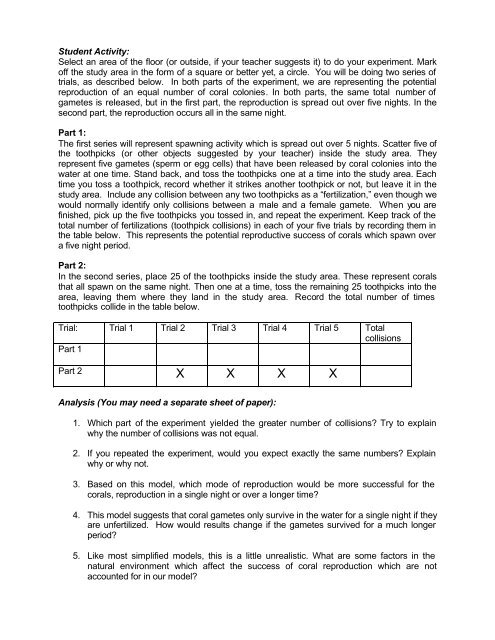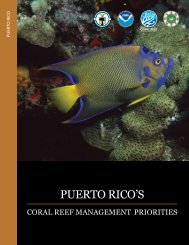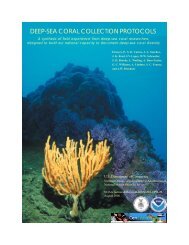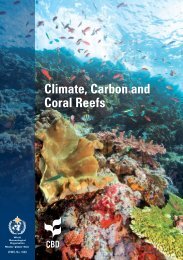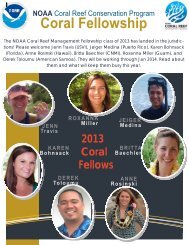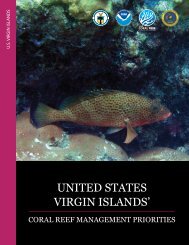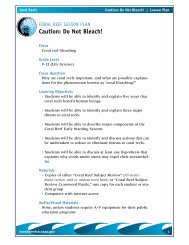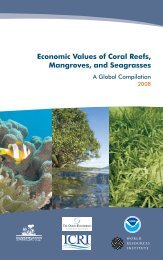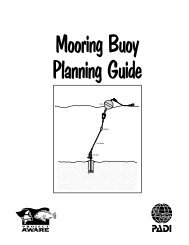Broadcast Spawning in Corals - NOAA's Coral Reef Conservation ...
Broadcast Spawning in Corals - NOAA's Coral Reef Conservation ...
Broadcast Spawning in Corals - NOAA's Coral Reef Conservation ...
You also want an ePaper? Increase the reach of your titles
YUMPU automatically turns print PDFs into web optimized ePapers that Google loves.
Student Activity:<br />
Select an area of the floor (or outside, if your teacher suggests it) to do your experiment. Mark<br />
off the study area <strong>in</strong> the form of a square or better yet, a circle. You will be do<strong>in</strong>g two series of<br />
trials, as described below. In both parts of the experiment, we are represent<strong>in</strong>g the potential<br />
reproduction of an equal number of coral colonies. In both parts, the same total number of<br />
gametes is released, but <strong>in</strong> the first part, the reproduction is spread out over five nights. In the<br />
second part, the reproduction occurs all <strong>in</strong> the same night.<br />
Part 1:<br />
The first series will represent spawn<strong>in</strong>g activity which is spread out over 5 nights. Scatter five of<br />
the toothpicks (or other objects suggested by your teacher) <strong>in</strong>side the study area. They<br />
represent five gametes (sperm or egg cells) that have been released by coral colonies <strong>in</strong>to the<br />
water at one time. Stand back, and toss the toothpicks one at a time <strong>in</strong>to the study area. Each<br />
time you toss a toothpick, record whether it strikes another toothpick or not, but leave it <strong>in</strong> the<br />
study area. Include any collision between any two toothpicks as a “fertilization,” even though we<br />
would normally identify only collisions between a male and a female gamete. When you are<br />
f<strong>in</strong>ished, pick up the five toothpicks you tossed <strong>in</strong>, and repeat the experiment. Keep track of the<br />
total number of fertilizations (toothpick collisions) <strong>in</strong> each of your five trials by record<strong>in</strong>g them <strong>in</strong><br />
the table below. This represents the potential reproductive success of corals which spawn over<br />
a five night period.<br />
Part 2:<br />
In the second series, place 25 of the toothpicks <strong>in</strong>side the study area. These represent corals<br />
that all spawn on the same night. Then one at a time, toss the rema<strong>in</strong><strong>in</strong>g 25 toothpicks <strong>in</strong>to the<br />
area, leav<strong>in</strong>g them where they land <strong>in</strong> the study area. Record the total number of times<br />
toothpicks collide <strong>in</strong> the table below.<br />
Trial: Trial 1 Trial 2 Trial 3 Trial 4 Trial 5 Total<br />
collisions<br />
Part 1<br />
Part 2 X X X X<br />
Analysis (You may need a separate sheet of paper):<br />
1. Which part of the experiment yielded the greater number of collisions? Try to expla<strong>in</strong><br />
why the number of collisions was not equal.<br />
2. If you repeated the experiment, would you expect exactly the same numbers? Expla<strong>in</strong><br />
why or why not.<br />
3. Based on this model, which mode of reproduction would be more successful for the<br />
corals, reproduction <strong>in</strong> a s<strong>in</strong>gle night or over a longer time?<br />
4. This model suggests that coral gametes only survive <strong>in</strong> the water for a s<strong>in</strong>gle night if they<br />
are unfertilized. How would results change if the gametes survived for a much longer<br />
period?<br />
5. Like most simplified models, this is a little unrealistic. What are some factors <strong>in</strong> the<br />
natural environment which affect the success of coral reproduction which are not<br />
accounted for <strong>in</strong> our model?


